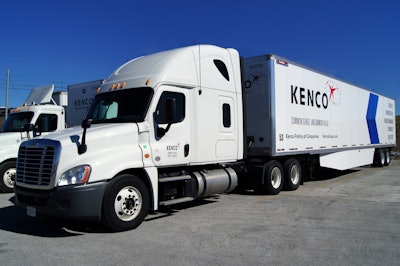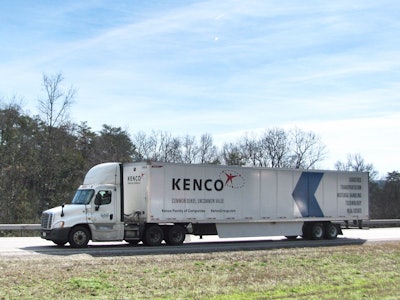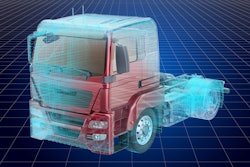
The world is changing and along with it, so is the logistics industry. Third-party logistics companies are learning to take new technologies under their belt to help better serve their customers and this includes Kenco Group.
In this Q&A, Kenco Chief Operating Officer David Caines talks with Supply and Demand Chain Executive about the growth of the company and how it focuses on customer service during this time as to not lose sight of what the business is. Along with that growth, the company is taking on new technologies that can help its partners and is also looking for new employees in different areas than it previously has. The logistics world is changing and Kenco plans to steer the car.
SDCE: Are you seeing the 3PL space evolving and if so, in what ways is that occurring and how is it affecting your customers?
Caines: Absolutely. In the last five years there has been the most change in my career in the 3PL industry than any time prior. Obviously, that's heavily driven by e-commerce requirements and fulfillment as well as the proliferation of technology tools.
The business model of 3PLs, as well as the services we provide, and the way we provide them have all been evolving over the last five to 10 years. One specific way is the proliferation of technologies. There is no shortage of technology and automation providers, which is a great thing because it helps provide options and modernize the industry, but it's also something that has to be taken account for 3PLs since we are the experts for our customers on best practices within the industry. It adds to the challenge for us to ensure we are always knowledgeable about what those new and innovative solutions are and under what scenarios can they best be applied.
Another area where the evolutions really occurred is in service level. So obviously 3PLs are service organizations, and so you would think that would be ingrained in the business and the solution, but what we've seen is as consolidation has occurred in the industry, the level of service provided by logistics providers has begun to vary greatly. We hear frequently from our customers that they're just not getting the service that they used to or that they expect, because they can't get the attention of the right senior leadership or there's private equity that owns their 3PL, and so it's all about just driving to a particular number. There's a lot of different reasons that are impacting that.
But in general, the expectations of service from customers continue to grow and rightfully so. And so those 3PLs who are focused on meeting and exceeding those service levels are becoming rarer in the industry.
SDCE: What are some of Kenco’s key priorities for 2020 and onward?
Caines: Finding the right labor, not just finding labor in general, but the right labor for all our positions. As a fast-growing industry, as well as a fast-growing company, finding the right labor, whether it's on the floor, in a distribution center, drivers in our dedicated contract carriage solutions or technology and data scientists within our headquarters and engineering offices, labor is tight. Finding the right labor and the right employee base that fits both the culture and has the capabilities gets more and more difficult every day.
The other area just for us individually is continuing to manage our steady growth. As I mentioned, we're a relatively fast-growing company within a fast-growing industry. We want to ensure that we continue to manage that growth effectively to continue to provide that level of service I referenced. For us as a private, family-owned company, service to our customers is key. We don't ever want to lose that culture of service, and so managing that growth effectively is critical.
And a final point I'd make on that would be all the inputs that go into our business, the costs and the costs’ impact on our customers continues to rise. Whether you're talking about labor, real estate costs, equipment costs or tariffs applied to import, those costs continue to rise. Therefore, the management of those costs on behalf of our customers is critical. And, helping educate our customers on where those cost increases are coming from, what they should expect, and how they can manage their own budget becomes a critical aspect of our business.
SDCE: In terms of labor, are you finding that you are needing to reinvent the positions to attract the type of talent that you're looking for? Especially now with robotics playing such a big role in warehouses and DCS, are you finding the types of positions that you are looking for or are you having to start to retool those or rework those?
Caines: Our job descriptions and our expectations have stayed relatively consistent. What we have become more flexible on is the background of the people that we're looking for, and how can we train them and coach them in order to be able to move into some of these roles that traditionally we haven't looked for. That could be a data analytics role and looking at liberal arts grads as opposed only looking at engineering grads. As data analytics becomes as much a social science as it does a hard science, it's critical to have those other thoughts and opinions brought into the conversation. There is some level of evolution there, as we look at our roles and look at our more traditional definition of optimal candidate.
We're also looking at how to make more flexible schedules. How do we recruit in areas of the economy that perhaps we did not focus on before. An example of that is our partnership with HapiGig whose model is to help warehouse workers find fully flexible part-time positions. So you're a highly qualified forklift driver who has a full-time job, but is looking to pick up a few extra hours on the weekend or perhaps after your other shift, but you can't commit to it on a long-term basis. HapiGig helps match up employers such as ours who are always looking for great people to come in and do good work, and helps us then identify those, that different area of employee base in the market that we hadn't been able to tap into in the past.
SDCE: Where does Kenco see its biggest opportunities?
Caines: A big one for us is continuing to ride the wave of e-commerce fulfillment. We're doubling down on those capabilities as the demand for those services grows throughout the economy. That is a key area of opportunity for us.
Another one is in the whole evolution around material handling management. So as companies begin to automate portions of their distribution network along they also need to maintain the more traditional aspects of their material handling. They need a partner who has an engineered solution and a data-driven solution to bring insights on the best way to maintain and service and procure those types of equipment. And that is a key aspect of our business and a differentiator for us within the 3PL industry.
 Kenco
Kenco
Caines: Two areas come to mind quickly. One is in automation within the distribution network. So especially in the warehouse, a variety of automation solutions. Whether that's robotic picks, goods-to-manned robotics, it is all highly sophisticated sortition and conveyor systems. So from emerging technologies that technology continues to become more efficient at handling a broader range of products. And the commercial models for working with those companies continue to evolve, which have made it significantly easier and more flexible for 3PLs like us to apply it within our network.
The other area is in artificial intelligence and data analytics. Everything from robotic process automation technologies, which frankly are a slam dunk within 3PL for back office transportation management functions or invoicing activities. RPA is a real-time solution that can be applied both internally as well as externally for our customers. Then there are a myriad of other AI type driven solutions such as predictive analytics, digital transformations like helping our customers with their digital transformation of their supply chain and a variety of advanced analytics solutions. Those are the items that are getting applied within real time here within the next 12 months and creating value very quickly for our customers.
SDCE: Innovation and collaboration as one of the leading areas then is helping your customers sort of take that next step in digital transformation and within their supply chain?
Caines: Absolutely. The digital transformation or advanced analytics is by far where we can have the biggest impact on their network, on their supply chain network. There is a lot of great automation solutions out there and many great one-off technologies that help such as a freight broker, freight matching or marketplaces.
But those solutions do not apply to every customer, whereas the digital transformation advanced analytics can apply to essentially every customer we talk to. Everyone has a need to better access the data within their supply chain, and then more importantly, have experts aid them in drawing conclusions from and proactively managing that network using that data.
SDCE: With so many solutions out there, what would be your advice for ways to cut through all that and find the solutions that are ideal for your business and help support your business as well as your customers and suppliers?
Caines: Well that's a bit of a loaded question for me, because I'm going to tell you it's work with your 3PL partner.
How we look at it is the key role of a 3PL is to be the knowledge expert on best practices within the industry. We fully believe that investment in things such as innovation labs is table stakes these days. In order to be able to show real solutions to our customers, we take it as our responsibility to vet those technologies and those automation solutions so that we can talk intelligently to our customers about which scenarios do certain solutions work and which scenarios they don't work. And then we make recommendations to them based upon equipment solution diagnostic, but based upon what is best for the customer, not what is best for technology companies.




![Pros To Know 2026 [color]](https://img.sdcexec.com/mindful/acbm/workspaces/default/uploads/2025/08/prostoknow-2026-color.mduFvhpgMk.png?auto=format%2Ccompress&bg=fff&fill-color=fff&fit=fill&h=100&q=70&w=100)







![Pros To Know 2026 [color]](https://img.sdcexec.com/mindful/acbm/workspaces/default/uploads/2025/08/prostoknow-2026-color.mduFvhpgMk.png?ar=16%3A9&auto=format%2Ccompress&bg=fff&fill-color=fff&fit=fill&h=135&q=70&w=240)




